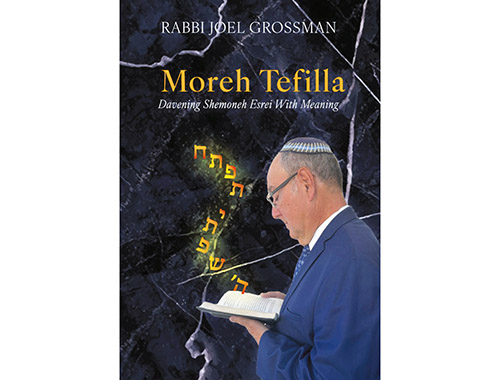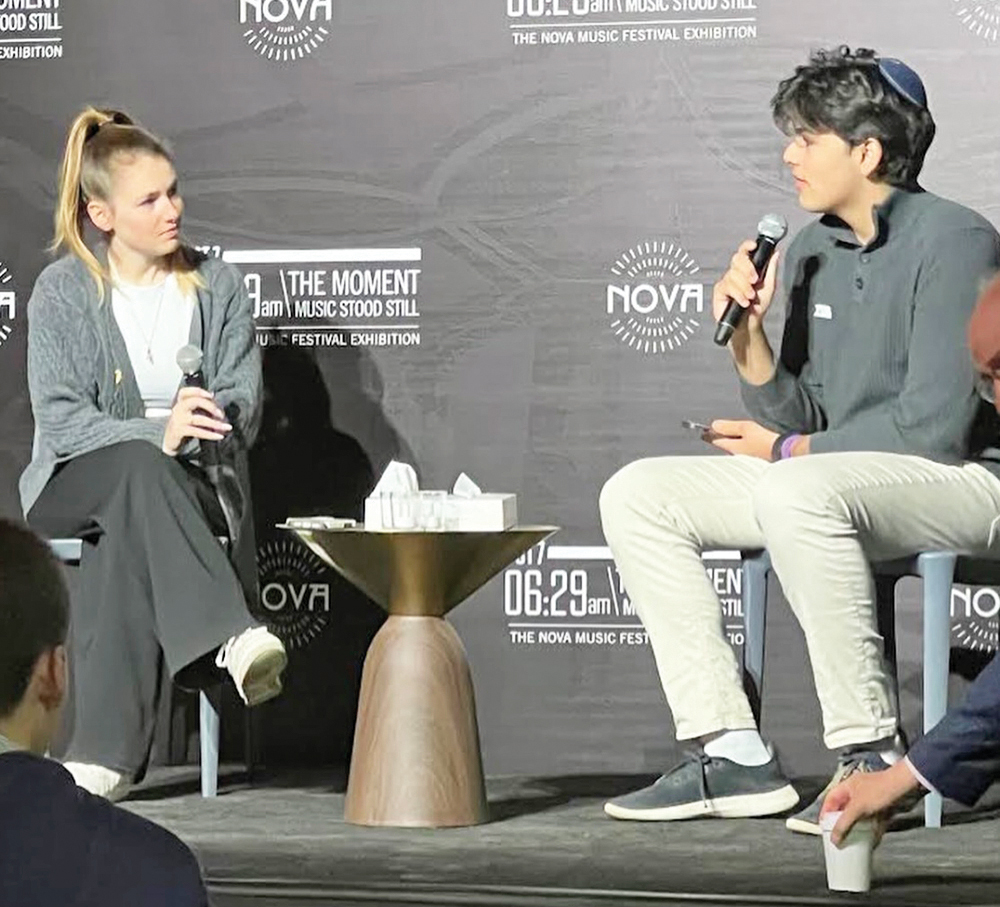
Reviewing: “Moreh Tefilla: Davening Shemoneh Esrei With Meaning,” by Rabbi Joel Grossman. Independently published. 2023. English. Hardcover. 287 pages. ISBN-13: 979-8388271105.
Who but a veteran rebbe of high schoolers would understand the need to clarify and explicate the meaning of our daily tefillot. During his 29 years serving as a beloved rebbe at Torah Academy of Bergen County (TABC) in Teaneck, Rabbi Joel Grossman was able to instill a reverence and understanding of Torah B’chtav and Torah She’be’alpeh in his talmidim. Equally important to him was developing in them an appreciation and comprehension of the order and intent of the daily tefillot.
Shortly before this past Pesach, Rabbi Grossman’s sefer entitled “Moreh Tefilla:

Davening Shemoneh Esrei With Meaning” was published amid great simcha. The sefer will serve as an inspirational guide to teens as well as adults as they gain clarity into the intent of the three sections of the daily Shemoneh Esrei. In the words of Rabbi Josh Kahn, soon to be head of school at TABC, “For hundreds of former students, reading Rabbi Grossman’s sefer will be a revisit to the many special hours spent in his classroom.”
Rabbi Grossman earned his semicha in 1983 from the Rav, Dr. Norman Lamm and Rabbi Zevulun Charlop. He was selected as one of two RIETS musmachim to go on to earn Yadin Yadin semicha under the tutelage of Rav Nissim Alpert in 1985.
Growing up in Monsey, his expertise in learning became evident early on. After the petira of his beloved father Rav Isaac Yitzchak Tendler, z”l Rav Moshe Tendler called upon the then 18- year- old Grossman to learn Masechet Nedarim with his young son Elidan in preparation for his bar mitzvah. The two covered 100 blatt in one year. Grossman attributes that special accomplishment to the precious note he received from Rav Moshe Feinstein in October of 1981 which he includes among the haskomot in his sefer. “B’Ezras Hashem, I hereby bless our very dear and respected friend Mori Harav Yosef Grossman, shlita, who is immersed in the Torah and the pure fear of God. May Hashem Yisbarach have him succeed in all things, physical and spiritual, with great success. Your close friend, Moshe Feinstein, Isru Chag, Sukkot 5742.”
Other haskomot which are cited in the sefer comes from Torah luminary Rav Hershel Schachter and Rabbi Yosef Adler, former rosh yeshiva of TABC, under whom Rabbi Grossman worked throughout his teaching career. Rabbi Chaim Jachter, colleague and rav of Congregation Shaarei Orah, the Sephardic Congregation of Teaneck, offered, “Rabbi Joel Grossman is one of the top Torah educators of our generation. I served with him as a Rebbe at TABC for more than 20 years and was continually amazed and enthralled at his ability to connect with his Talmidim and transmit Torah to students of all abilities and all ages … I am thrilled to see that Rav Grossman has released a Sefer on the critical topic of Tefilla. As with his classroom teaching, Rav Grossman is superlative. I highly recommend Rav Grossman’s Sefer. It belongs in the home of every English-speaking Jewish family.”
Rav Grossman divides his sefer into four components. In his introductory section, he offers a general background to tefillah, followed by a specific overview of Shemoneh Esrei and its fundamentals. In his section devoted to Praise, he speaks of the Avos and the sanctifying of Hashem’s name. In the Bakasha, Entreaties Section, he elaborates on the concepts of knowledge, redemption, ingathering of the exiles, healing, blessings of the years, slanderers, Jerusalem, and the offspring of David among other topics. In the fourth section on Gratitude he discusses the Avodah, Thanksgiving, establishing peace, guarding one’s tongue and hope for the future.
Throughout the sefer, Rabbi Grossman brings citations from Chazal and Torah giants from the past as well as modern Torah scholars. He provides us with classic concepts which enhance our appreciation of tefillot. In his introduction, he offers, “Shemoneh Esrei is of such paramount importance that whenever the Mishna refers to Tefilla, it is talking about Shemoneh Esrei …The Gemara tells us that when it comes to learning Torah, we are obligated to split our time into thirds: a third of our time for Torah, a third for Mishna, and a third for Gemara … Rav Amram Gaon, in the ninth century, understood the problem (of time) and solved it by putting the required formula of learning within the davening itself. Following the Blessing on the Torah, Rav Amram Gaon put in a few pesukim of Torah (which is our Korbanot), a few lines of Mishna (Eizehu Mekoman), and a few lines of Gemara (Braisa D’Rabi Yishmael Omer). Thus even if one does not learn anything else the whole day, they will have fulfilled the dictum of learning Torah, Mishna and Gemara through their davening.”
Interspersed throughout the sefer are anecdotes presented in squared-off boxes. These short vignettes, often taken from contemporary scenarios, add to the flavor and relevance of the sefer. An example of one of many is the story following this reference to “the Slanderers.”
“The original text of Shemoneh Esrei, introduced by the Anshei Knesset HaGedolah and reintroduced by Shimon HaPakuli, had 18 brachot. The nineteenth bracha was instituted later by Shmuel HaKatan and read “And for the slanderers let there be no hope.” The following boxed-in vignette is then offered.
“Shmuel was called HaKatan, the small one, to emphasize his humility. Only someone with such great humility is capable of initiating a bracha against slanderers, as any other type of person who made a bracha against other Jews would be suspected of having an ulterior motive…One time when Rav Moshe Feinstein was in Monsey, somebody asked his son Rav Reuven, ‘How did your Father become the Gadol Hador?’ Rav Reuven responded, ‘I’ll be honest. My Father never campaigned; he never had a TV debate like politicians. Somebody would call him up with a question and liked the answer he received. Then others heard about this and also called him up with a question. That’s how he eventually became the Gadol Hador. So too Shmuel HaKatan was too humble to call himself HaKatan. But because of his humility which everyone recognized, he was zocheh to compose ‘V’la’malshinim.”
To purchase a copy of “Moreh Tefilla:Davening Shemoneh Esrei With Meaning” by Rabbi Joel Grossman visit www.amazon.com/Moreh-Tefilla-Davening-Shemoneh-Meaning/dp/BOBZF8WGPC.
Pearl Markovitz is a senior staff writer at The Jewish Link.













